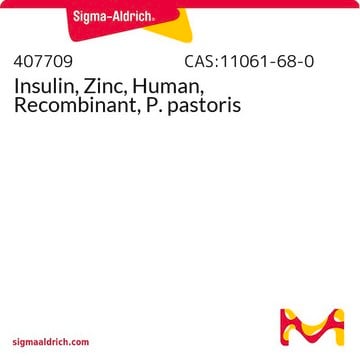I2643
Insulin human
recombinant, expressed in yeast (proprietary host)
About This Item
Recommended Products
biological source
human
recombinant
expressed in yeast (proprietary host)
sterility
non-sterile
assay
≥98% (HPLC)
form
powder
potency
≥27.5 units/mg (dried basis)
technique(s)
cell culture | mammalian: suitable
solubility
0.01 M HCl: 20 mg/mL, clear, colorless
UniProt accession no.
shipped in
ambient
storage temp.
−20°C
InChI key
PBGKTOXHQIOBKM-FHFVDXKLSA-N
Gene Information
human ... INS(3630)
Looking for similar products? Visit Product Comparison Guide
Application
- in the culture medium needed for the adipogenesis of ASCs (adipose-derived stem cells)
- to study the effect of insulin in the young and aged brains of rats.
- to study the effect of insulin on the inflammatory actions of protease-activated receptor 2 (PAR2) using mice model.
Biochem/physiol Actions
Other Notes
Related product
Storage Class
11 - Combustible Solids
wgk_germany
nwg
flash_point_f
Not applicable
flash_point_c
Not applicable
ppe
Eyeshields, Gloves, type N95 (US)
Certificates of Analysis (COA)
Search for Certificates of Analysis (COA) by entering the products Lot/Batch Number. Lot and Batch Numbers can be found on a product’s label following the words ‘Lot’ or ‘Batch’.
Already Own This Product?
Find documentation for the products that you have recently purchased in the Document Library.
Customers Also Viewed
Protocols
TrueGel3D® Hydrogel Plate protocol guides high-throughput culture of human adipose MSCs for screening applications.
Our team of scientists has experience in all areas of research including Life Science, Material Science, Chemical Synthesis, Chromatography, Analytical and many others.
Contact Technical Service











